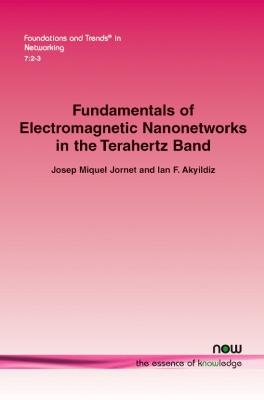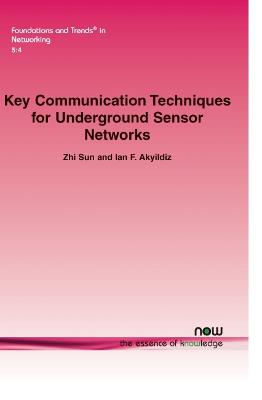Foundations and Trends (R) in Networking
2 total works
Fundamentals of Electromagnetic Nanonetworks in the Terahertz Band
by Josep Miquel Jornet and Ian F. Akyildiz
Published 5 December 2013
It is widely accepted that nanonetworks will enable a plethora of long-awaited applications, ranging from healthcare to homeland security, industrial development and environmental protection. Enabling communication among nanomachines is still a major challenge.
While it is acknowledged that there is still a long way to go before having a fully functional nanomachine, this book makes the case that hardware-oriented research and communication-focused investigations will benefit from being conducted in parallel from an early stage.
Fundamentals of Electromagnetic Nanonetworks in the Terahertz Band defines the first steps towards enabling electromagnetic communication among nanomachines in the Terahertz Band (0.1-10 THz). The starting point is the development of novel graphene-based plasmonic nano-antennas, which efficiently operate in the Terahertz Band. The authors have developed a novel Terahertz Band channel model and investigated the potential of this frequency band by means of a channel capacity analysis. In light of the channel peculiarities and the nanomachine capabilities, they put forward a set of communication mechanisms for nanonetworks, which include femtosecond-long pulse-based modulations, low-weight channel coding schemes, a new symbol detection scheme at the receiver, and a new medium access control protocol for nanonetworks.
In addition, the book analyzes the performance of perpetual nanonetworks by developing a joint energy harvesting and energy consumption model for self-powered nanomachines. Finally, an emulation platform has been developed to simulate a one-to-one nano-link between nanomachines and validate the developed models.
While it is acknowledged that there is still a long way to go before having a fully functional nanomachine, this book makes the case that hardware-oriented research and communication-focused investigations will benefit from being conducted in parallel from an early stage.
Fundamentals of Electromagnetic Nanonetworks in the Terahertz Band defines the first steps towards enabling electromagnetic communication among nanomachines in the Terahertz Band (0.1-10 THz). The starting point is the development of novel graphene-based plasmonic nano-antennas, which efficiently operate in the Terahertz Band. The authors have developed a novel Terahertz Band channel model and investigated the potential of this frequency band by means of a channel capacity analysis. In light of the channel peculiarities and the nanomachine capabilities, they put forward a set of communication mechanisms for nanonetworks, which include femtosecond-long pulse-based modulations, low-weight channel coding schemes, a new symbol detection scheme at the receiver, and a new medium access control protocol for nanonetworks.
In addition, the book analyzes the performance of perpetual nanonetworks by developing a joint energy harvesting and energy consumption model for self-powered nanomachines. Finally, an emulation platform has been developed to simulate a one-to-one nano-link between nanomachines and validate the developed models.
Key Communication Techniques for Underground Sensor Networks
by Zhi Sun and Ian F. Akyildiz
Published 25 April 2012
Wireless Underground Sensor Networks (WUSNs) are the networks of wireless sensors that operate below the surface of the ground. The networks of wireless nodes are buried underground and communicate through soil. WUSNs can enable many novel and important applications, such as in-situ oil reservoir monitoring, concealed border patrol, underground power grid and pipelines maintenance, intelligent irrigation, earthquake and landslide forecast, mine disaster prevention and rescue, among others. Despite the potential advantages, the underground soil medium brings distinctive and significant challenges, which prevent the direct usage of most, if not all, existing communication and networking techniques.
In Key Communication Techniques for Underground Sensor Networks, two enabling techniques are developed to realize reliable and efficient WUSNs, namely the EM wave-based WUSNs and the MI-based WUSNs. The book provides principles and guidelines for readers who are interested in WUSN designs. Specifically, for EM wave-based WUSNs, the dynamic network connectivity is first investigated based on a comprehensive channel model in the soil medium. Then, a spatio-temporal correlation-based data collection scheme is developed to reduce the sensor density while keeping high monitoring accuracy.
For MI-based WUSNs, the MI waveguide technique is first developed to significantly enlarge the underground transmission range. Then, the optimal deployment algorithms are analyzed to construct the WUSNs with high reliability and low costs. Finally, the mathematical models are developed to evaluate the channel and network capacities of MI-based WUSNs.
This is the perfect reference for anyone interested in the research contributions, design challenges and considerable potential of WUSNs.
In Key Communication Techniques for Underground Sensor Networks, two enabling techniques are developed to realize reliable and efficient WUSNs, namely the EM wave-based WUSNs and the MI-based WUSNs. The book provides principles and guidelines for readers who are interested in WUSN designs. Specifically, for EM wave-based WUSNs, the dynamic network connectivity is first investigated based on a comprehensive channel model in the soil medium. Then, a spatio-temporal correlation-based data collection scheme is developed to reduce the sensor density while keeping high monitoring accuracy.
For MI-based WUSNs, the MI waveguide technique is first developed to significantly enlarge the underground transmission range. Then, the optimal deployment algorithms are analyzed to construct the WUSNs with high reliability and low costs. Finally, the mathematical models are developed to evaluate the channel and network capacities of MI-based WUSNs.
This is the perfect reference for anyone interested in the research contributions, design challenges and considerable potential of WUSNs.

